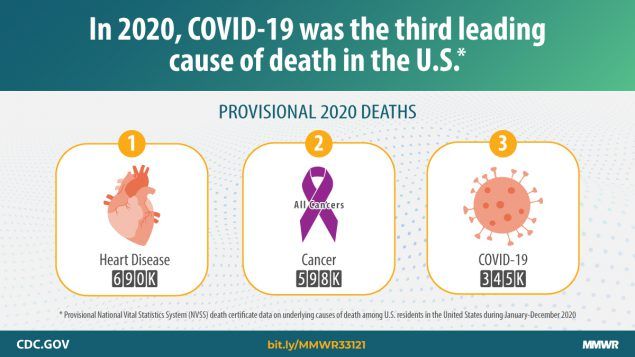Header image: Jakayla Toney on Unsplash
It typically takes 11 months for the CDC to release mortality data for the previous year. However, the agency put its foot on the gas this year due to the "pressing need for updated, quality data during the global COVID-19 pandemic." As a result, we have this report, a preliminary look at the mortality rate in the U.S. in 2020 and how COVID-19 impacted it. (The CDC will release more official data later in the year.)
Below are some top insights from the report.
COVID-19 was the third leading cause of death in 2020

Heart disease and cancer were still the most common causes of death by a significant margin, though it's notable that COVID-19, in a little more than nine months, caused 345,000 deaths, as there's typically a steep drop-off between the top two causes of death and all others in any given year.

If the numbers for 2020 were reflected in the graph above, the bar for COVID-19 would be about equidistant between "cancer" and "accidents," between 104 and 110 deaths per 100,000, depending on which figures you use.
Suicide, typically the 8th, 9th, or 10th most common cause of death in the U.S., was bumped out of the top 10 in 2020 by COVID-19.
Others died with COVID-19, though it may not have been the primary cause.
You can see in the first image above that COVID-19 caused 345,000 deaths in 2020. (It was 345,323, to be precise.) But COVID-19 was listed as an underlying or a contributing cause in 377,883 deaths. That's about 32,000 deaths that may have been caused by an underlying health problem while someone had a COVID-19 infection.
Of course, this discrepancy is difficult to be exact about. It's up to a doctor filling out a death certificate to determine what caused an individual's death. If an elderly patient who already suffers from kidney disease gets COVID-19 and dies, it may not be possible to determine with certainty if COVID-19 was the specific cause of death. That is, had the patient not contracted the coronavirus, would they have survived? It's especially tricky since COVID-19 is deadliest in the elderly, who are already more likely to have other health issues.
Nevertheless, the stark increase in death rates, especially among the older population, indicates that COVID-19 is destructive enough to be considered a primary cause of death, regardless of underlying health causes. Put another way – while COVID-19 worst affects people with other health problems, the majority of those 377,883 people would still be alive if it wasn't for the pandemic.
Communities of color were hit the hardest
Overall death rates were highest among the Black and American Indian/Alaska Native populations, and COVID-19-associated death rates were highest among the Hispanic and American Indian/Alaska Native populations. 187.8 out of every 100,000 individuals in that latter group died from COVID-19 in 2020, compared to 72.5 out of 100,000 non-Hispanic white Americans, and 66.7 out of 100,000 Asian Americans.
Challenges have persisted into 2021, with Black and Hispanic Americans receiving a smaller proportion of vaccines in relation to their overall case numbers. These figures vary across states, but in general, white people were more likely to receive a COVID-19 vaccine, as of late March, than Black or Hispanic people.
COVID-19 will remain one of the top causes of death in 2021
The winter viral surge caused an increase in deaths early in the new year. About 200,000 people have died of COVID-19 since January, which means it would probably stay firmly in that third spot even if the pandemic ended today.
If the vaccine rollout continues successfully and new surges are abated, there should at least be fewer COVID-19 deaths than in 2020, which would decrease the overall age-adjusted death rate. That rate was up 15.9% from 2019, with more than 100 more deaths per 100,000 people.
Share this article on Twitter.
About the writer: Jonathan Harris is a writer for Inside.com. Previously, he wrote for The Huffington Post, TakePart.com, and the YouTube channel What’s Trending.




